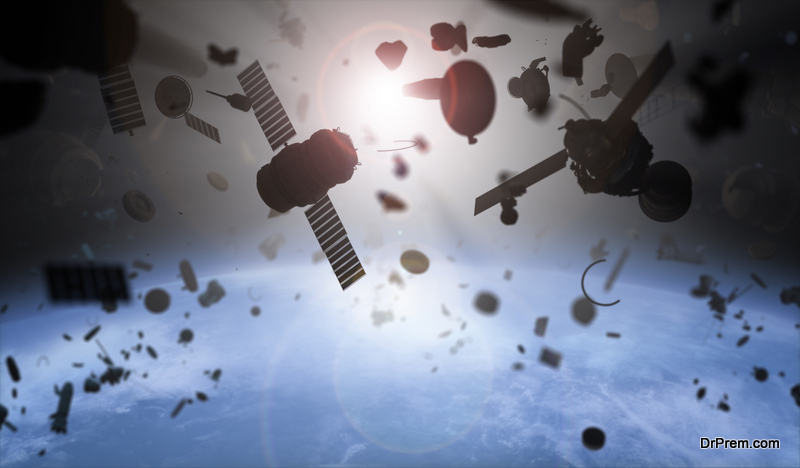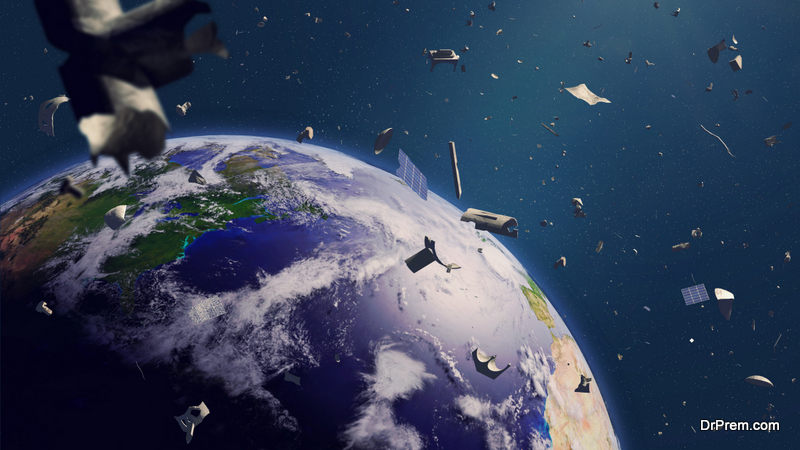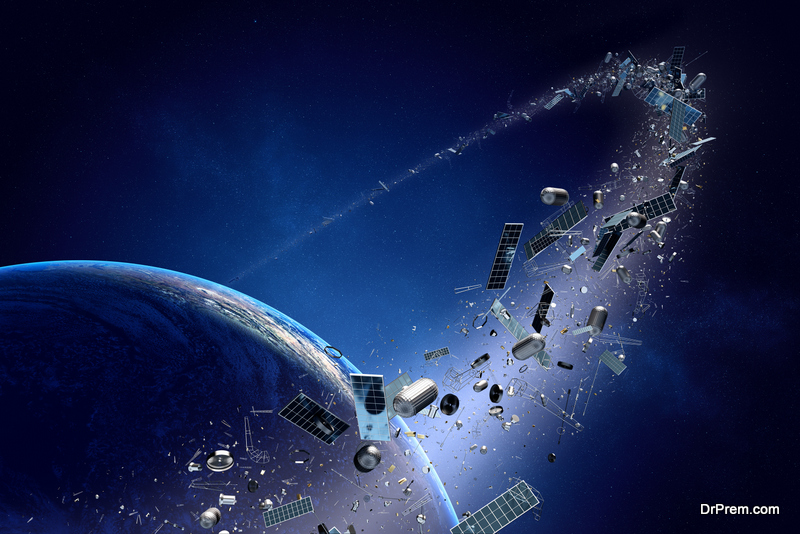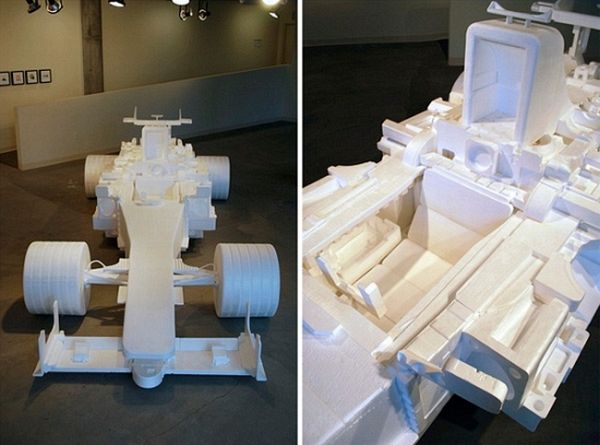NASA estimates that there are more than 500,000 debris pieces orbiting Earth. The space junk travels at blasting speeds and poses a great threat to satellites. Some of the space junk is quite small, but some of those are bigger than softballs. When you look up at the sky you may not be able to see it, but mingling with the starlight is 300 billion dollars worth of smashed sats, rocket fragments et al cluttering up the atmosphere above the earth. Space debris is a huge problem now and one of the solutions could be recycling it. So is it really possible recycle space debris?
How to recycle space debris
 To reduce space junk, one of the ways is to recycle space junk and use it to manufacture new satellites. Instead of manufacturing new satellites on earth, a system could be put in place which would recover the junk and use it to make new sats in space itself. The recycling system would also have the power to vaporize tiny space debris thereby clearing the path for orbiting satellites. The system would be solar powered and thus operate using the most amazing energy source in the galaxy.
To reduce space junk, one of the ways is to recycle space junk and use it to manufacture new satellites. Instead of manufacturing new satellites on earth, a system could be put in place which would recover the junk and use it to make new sats in space itself. The recycling system would also have the power to vaporize tiny space debris thereby clearing the path for orbiting satellites. The system would be solar powered and thus operate using the most amazing energy source in the galaxy.
The Northrop Grumman space junk recycler
The aerospace company Northrop Grumman has some great plans for a space recycler, to recycle space debris. The structure would have a huge parabolic reflector, between 50-100 feet in diameter, a spherical crucible which would be made of a material having a high melting point. There would be several compartments in which different types of salvaged materials would be stored. Hi-tech robotic arms would capture space debris and abandoned or ‘dead’ satellites.
The reflector of the recycler would be able to concentrate the sun’s heat into a small space, spherical in shape. An intense heat would be created which could be used to vaporize the debris floating around nearby, or heat larger debris in the crucible of the recycler. The crucible would behave like a rotating rotisserie and heat the space debris to an uniform temperature. In this manner, different types of materials would be melted and captured. This method sounds like a doable method to recycle space debris.
Storing the recovered materials in space
 The Northrop group plans to store the materials in different compartments in ingot form. Or the materials could be piped to another part of the recycler in real time, to become the raw material for manufacturing in-space. The leftover material can be compressed into small sizes and vaporized by solar concentrator.
The Northrop group plans to store the materials in different compartments in ingot form. Or the materials could be piped to another part of the recycler in real time, to become the raw material for manufacturing in-space. The leftover material can be compressed into small sizes and vaporized by solar concentrator.
Another interesting concept is that the recycler could be self-sustaining. According to the company’s researchers, when the mirror surface of the concentrator becomes contaminated, the recycler can vaporize space scrap aluminum and recoat itself. The concentrator would be very reflective and work as effectively as before.
Where to scavenge for space junk
The ideal locations to collect space junk are the ‘graveyard’ orbits. These orbits are many hundred kilometers above the earth. Graveyard sats are drained of both batteries and fuel, so that they are completely empty and safe. Operational satellites are never found orbiting the graveyard orbits.
A recycler would be placed in the graveyard orbit, where it could access the dead satellites and recycle them. Or it could move from satellite to satellite, ‘ingest’ a whole satellite, and convert it to raw materials, and build a new sat in space and push it out for re-assembly. So recycling would save billions of dollars in money and be useful in cleaning up the Earth’s backyard too.
Other innovative methods to harvest space junk
 Surrey University in UK has launched RemoveDebris experiment, a program designed to harvest the space junk. The researchers have worked out an extremely simple yet ingenious design which has all the chances of being quite successful. They have modified harpoons and nets’ designs to catch the space debris, reduce their speed to the extent that they fall out of the orbit. This method might be effective in reducing the size of large sized space debris.
Surrey University in UK has launched RemoveDebris experiment, a program designed to harvest the space junk. The researchers have worked out an extremely simple yet ingenious design which has all the chances of being quite successful. They have modified harpoons and nets’ designs to catch the space debris, reduce their speed to the extent that they fall out of the orbit. This method might be effective in reducing the size of large sized space debris.
The team is experimenting also with RFID or Radio Frequency Identification Devices, which will be used by the ‘chaser ships’ to mark the debris which has to be removed. After the RFID tags are deployed, the harvester will ‘harvest’ the debris and bring it back to earth. The debris can then be recycled to manufacture new sats.
The RemoveDebris researchers carried out their first test in space, and incredibly, captured a piece of space junk without breaking it up! More projects like RemoveDebris are required for the cleaning up of the Earth’s orbits and to recycle space debris.
Satellites manufactured in space would be lighter, cheaper and smarter
There are several advantages of recycling satellites in space. A whole new generation of lighter and simpler satellites could emerge, which would be far more capable. The new gen recycled satellites could have lesser mass as well, as they would be free of the gravitational forces during the time of launch. They would probably look completely different from traditional spacecraft.
Instead of the many boxes with more than one additions, the sats built in space from recycled space junk materials would have a probably much more sleek design. The satellites might have just one panel – at the top, there could be an assembly of rf (radio frequency) electronics and elements, such as a large circuit board. Solar panels could be attached to the back of the sat to power the satellite.
Is recycling space junk economically viable right now?
 As every single venture on Earth is driven by the finance factor, even though it could be possible to recycle space debris, it is not economically profitable now. Though DARPA, the US Defense’s advanced research project, has a space junk cleanup plan since 2011, it has not as yet led to recycling of the debris.
As every single venture on Earth is driven by the finance factor, even though it could be possible to recycle space debris, it is not economically profitable now. Though DARPA, the US Defense’s advanced research project, has a space junk cleanup plan since 2011, it has not as yet led to recycling of the debris.
Space debris needs to be cleaned up as they are dangerous to the satellites in orbit. Colliding can damage satellites and have done so, in fact, which meant a threat to the astronauts and also to their ships. Recycling it is a good option, and it will soon become a reality.



